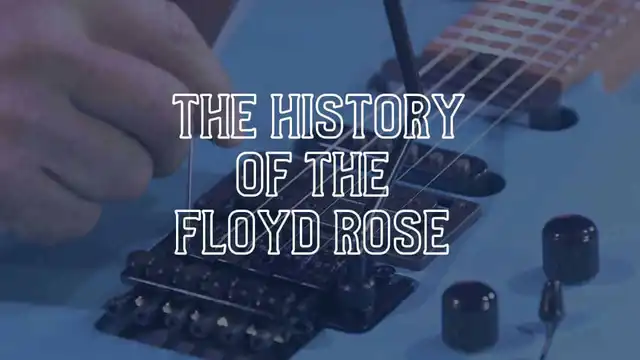Birth of the Divebomb: The History of the Floyd Rose Tremolo


The Floyd Rose tremolo is ubiquitous these days, used by players throughout a multitude of genres and styles. It’s hard to imagine the world of guitar without these divebomb and squeal-enabling devices.
But believe it or not, there was a time before those famous divebombs were possible... Floyds only arose in the late 70s and early 80s to meet the changing needs of guitarists, followed by a surprisingly quick process of adjustment to get the Floyd Rose we know today.
So, let’s go back and take a look at the development of the Floyd Rose tremolo, an undisputedly essential invention in the history of the electric guitar.

The First Prototypes
The story of the Floyd Rose tremolo starts with Floyd Rose the guitarist. Rose played a 50s Strat and utilized its tremolo arm to experiment with Hendrix-esque sounds. To his irritation, this practice led his guitar to consistently go out of tune.
Many other guitarists were similarly dissatisfied with Fender tremolos and desired a more stable, reliable option that wouldn’t go out of tune every couple of songs. For this reason, Floyd Rose began to work on his own tremolo design.
Rose realized that strings moving within the nut was the main source of tuning problems. At first he attempted to glue the strings in place, which actually worked until the glue broke down and lost its adhesive properties.
Rose moved his attention to the bridge and devised his first prototype. This crude device, built around a Bigsby and featuring a brass saddle and brass locking nut, was a far cry from the modern Floyd Rose. However, the principles of the design worked. With the basics tested, Floyd was ready to make some improvements.
Floyd’s second prototype from 1977 is the first to resemble a modern Floyd Rose tremolo. Unlike the Bigsby-based prototype, this model featured its own tremolo block and plate on top of the locking nut and bridge.
This second prototype represented a big step in the right direction, but it still had lots of room for improvement. Fine tuners are notably missing from this design. With a solid base to work from, Floyd went back to the shop to make more changes.
Floyd Rose in Production: FRT-1
The FRT-1 was officially released in 1982 and was the first commercially available Floyd Rose. Originally sold under the name ROSE, these units were very similar to the second prototype with minimal changes. The first 50 were hand made by Floyd, with the other limited run of approximately 500 units made in Japan.
Supposedly, Floyd was approached at NAMM in 1981 by Fernandes—a Japanese marketing company that sourced work out to factories. They showed him their copy of a FRT-1, and Floyd was so impressed that they formed an agreement to produce future Floyd Rose designs.
There is a lot of variance in the FRT-1s. Component parts such as screws varied depending on what Floyd had available, what the Japanese factories had available, and what techs could find for repairs.
While these Floyds weren’t perfect, they were good enough to make a huge impact. One of the first FRT-1s was sent to Eddie Van Halen, and it didn’t take long for him to become a Floyd Rose devotee and spark a huge increase in demand.

FRT-2 and Licensed Floyds
The FRT-2 is often considered the first officially licensed Floyd Rose tremolo even though it technically wasn’t a licensed product. This model was released simultaneously with the FRT-1, and both models were available to purchase from the Fernandes catalog.
FRT-1 and FRT-2 are very close in terms of build and quality with a few key differences. FRT-2 saddles featured chrome plated brass instead of steel. They also lacked insert blocks and locks at the saddles.
For these reasons, while still high quality, FRT-2s were cheaper than FRT-1s and were sold on Fernandes’ not-quite top of the line guitars. The FRT-2 would stay in production until 1985.
FRT-3
By the end of 1982, the first year that the FRT-1 was publicly available, it was replaced by the FRT-3. Fernandes also manufactured these Floyds, with production lasting until 1985. Wax molds produced by Rose himself were utilized to ensure the FRT-3 was made to his precise specifications.
The FRT-3 design was a refinement of the FRT-1, featuring a large steel sustain block, T-block inserts, and higher quality steel. They also had bent steel base plates and cast steel saddles. There is some variance amongst FRT-3s. Japanese factories made some slight changes in manufacturing depending on available materials and parts, though these were all minor changes.
Floyd also made some FRT-3s in his own shop, a number of which were sent to Charvel. These FRT-3s also varied a bit in construction, as Floyd would sometimes use Japanese made parts along with USA made parts.
With Floyds gaining popularity thanks to players like Eddie Van Halen, it was inevitable that copies would start to emerge. Companies such as ESP, Double Eagle, and Bracchus made Floyd clones of varying quality.

FRT-4
While the FRT-3 was a big success, there was one issue that guitarists kept bringing up—tuning. Strings would often go flat or sharp once the nut was locked.
Because of Floyd’s ability to make minute changes and fine tune his early prototypes, the issue wasn’t apparent. But once they hit mass production, this fine tuning problem became a notable issue.
With this deficiency in mind, Floyd began working on the FRT-4 in 1982. The FRT-4 was the first Floyd to feature fine tuners. Floyd collaborated on this design with Eddie Van Halen, who specifically asked that the fine tuners have enough range to go into drop D.
The FRT-4 represented a huge leap forward, allowing for fine adjustments that could mitigate any tuning issues caused by the locking nut.
FRT-4s were also made primarily by Fernandes with slight variations from run to run. However, the FRT-4 was only in production for a short period of time before being supplanted by the FRT-5.
The Floyd Rose: FRT-5
The FRT-5 is the first Floyd Rose that looks like the modern Floyd design with a “whale tail.” This change was also a suggestion of Eddie Van Halen, who thought the vertical fine tuners got in the way of his right hand.
Outside of the “whale tail” and change to the fine tuners, the FRT-5 is very similar to the FRT-4. However, those improvements made a world of difference to players, which is made apparent by the fact that this design is still in use today with few changes, some of which include minor adjustments to components that took place during the initial run from 1983 to 1985.
It was also around this time that Floyd Rose partnered with Kramer, catapulting it into one of the most popular and dominant guitar brands of the 1980s.
Floyd Rose Tremolos Today
In 1985, Floyd’s contract with Fernandes ended. Instead of continuing production in Japan, he partnered with Schaller in Germany. Most Floyds today are made in Germany, though they do offer budget models made elsewhere—such as the South Korean Floyd Rose Special.
Since 1985, Floyd Rose has continued making slight changes and improvements to the design. However, most of these models are still nearly identical to the original FRT-5. While some things have changed, that original design is hard to beat.
Other models introduced since then include the FRX, the Speedloader, and the Titanium Floyd. Still, the tried and true FRT-5 remains the most popular Floyd.
The Floyd Rose: Fast-Track to Perfection
As rock continued to evolve in the late 70s and early 80s, so did the needs of guitarists. Fender style tremolos simply couldn’t handle the more extreme tremolo styles of guitarists of that era, and Floyd Rose stepped in to solve the problem.
Over the course of less than a decade, Floyd went from making crude Bigsby-based brass prototypes in his basement to designing and mass producing the FRT-5, a design that is still enjoyed by millions of players worldwide.
It usually takes decades for that kind of innovation, but Floyd Rose found the fast track to perfection, creating a game-changing design in just a few years. So, grab a set of Stringjoys, wind up your Floyd, and divebomb in salute of the man who made tuning-stable wailing possible.
Other Posts you may like

Guitar Strings Order: How the Guitar is Tuned and Why

Two Handed Tapping: Our Top 8 Tappers of All Time

Which Guitar Strings Wear Your Fret Wire Down More?

What is Nashville Tuning? Its History, Best Guitar Strings & Uses

Guitar Scale Length Explained: String Tension & Playability

What Guitar Strings I Used To Play...
0 Responses
Leave a Reply
Your email address will not be published. Required fields are marked *

